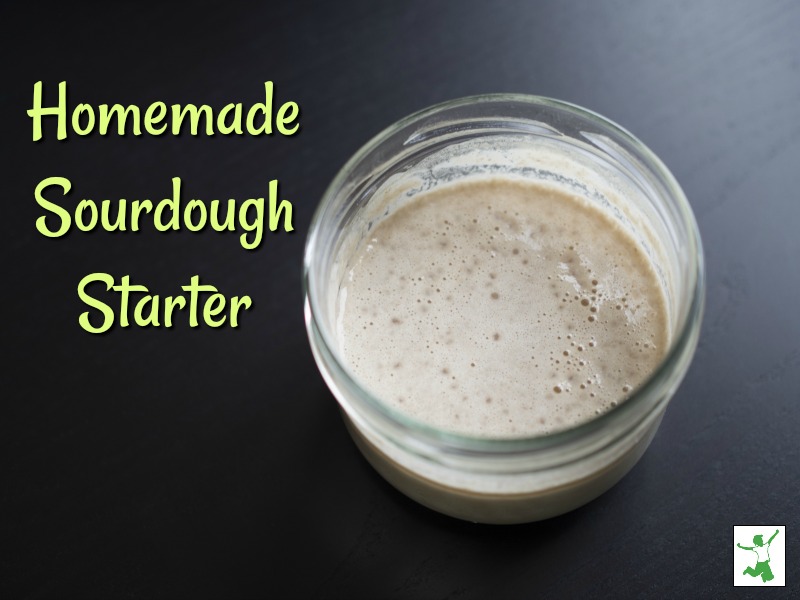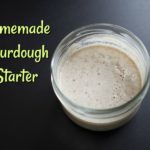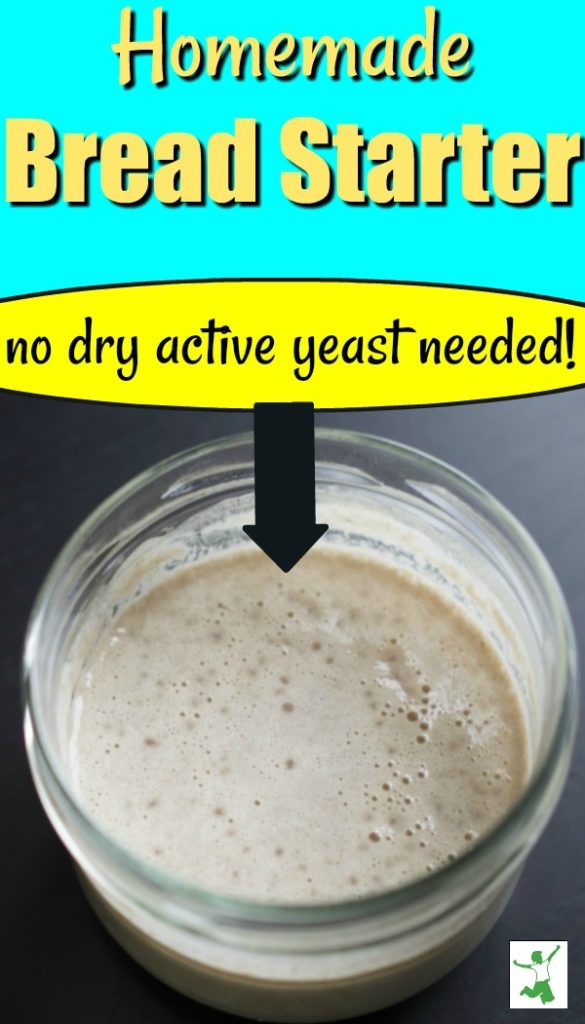Easy to follow homemade sourdough starter recipe to enjoy traditionally prepared, easy to digest sourdough bread made from whatever grain flour you choose. No active yeast required!
When I first got into Traditional Food in 2001, I pretty much had to make anything and everything myself. The reason is because there were few companies (and none in my local area) that made the type of food I was seeking. Worse, few people understood what I was even talking about! This was true even with the perennial favorite sourdough bread. My quest to learn how to make sourdough starter was usually met with puzzled expressions.
“Isn’t using yeast the proper way to get bread to rise? Isn’t this the way it’s always been done?” people would blankly ask.
“If the bread is organic, isn’t that good enough?”
Uh, no, no and no!
Yeast for breadmaking is relatively new in the grand scheme of human history. In fact, when baker’s yeast was first introduced as an alternative to true sourdough starter in France in the mid-1600s, it was strongly rejected. Renaissance scientists at the time knew that this quicker, more convenient approach to breadmaking would negatively affect public health.
Ancestrally prepared bread never contains added baker’s yeast!
Instead, traditionally baked bread utilizes a starter culture loaded with friendly Lactobacilli. This is a beneficial strain of bacteria found on the surface of all living things. Yes, it’s even crawling all over you right now if your skin is healthy and in proper pH balance.
In addition to the absence of baker’s yeast to make the bread rise, true sourdough bread as baked by traditional cultures throughout the world and by my own ancestors in Northern Europe – the type of bread ideal for my personal genome – is baked at a lower temperature for a longer period of time which protects the integrity of the proteins in the cereal grains as well as the nutritional value. This slower, more careful preparation method also eliminates anti-nutrients such as phytic acid. These substances interfere with proper digestion and block absorption of the minerals in the cereal grains. Traditional preparation also helps breaks down gluten, a very difficult to digest plant protein.
Best of all?
When you eat traditionally prepared sourdough bread (not the fake sourdoughs at the store that use yeast), you only eat a little because it is so filling!
The “bread makes you fat” argument is of much less concern when consuming traditionally prepared carbs. Eating the whole bread basket like what happens at the typical restaurant would not happen if those bread baskets were filled with true sourdough (and served with real butter of course!)
Homemade Sourdough Starter
Are you convinced yet that traditionally prepared bread is the way to go if you choose to consume carbs (which I do … I love bread!)
The next step then is to get hold of sourdough starter to try your hand at making a loaf.
Below are the directions I’ve always used to make sourdough starter, adapted, of course, from the must-have cookbook Nourishing Traditions!
Rye Flour Works Best (but you can go gluten free too)
Note that learning how to make sourdough starter really requires freshly ground rye flour. The chances of the starter “taking” are highest going this route.
If you use store-bought flour, even if organic, or another type of grain, it is likely the starter will not take and grow mold before it is ready. I know this from experience!
Note that even if your starter is made from rye, you can still use it to make sourdough bread with whatever flour you like!
To emphasize this point one more time, you will get your best results from making your sourdough starter with rye flour instead of wheat. Once your sourdough starter is ready, you can, of course, bake your bread with whatever grain you like. It’s just best to use rye for the starter alone .. you don’t have to make rye bread with it, in other words.
If you really want to make your sourdough starter with wheat, I would recommend einkorn. It is is the only heirloom wheat left on planet Earth that is completely unhybridized. By comparison, note that heirloom wheat like spelt, Kamut and emmer are hybridized! This is a frequent point of confusion.
Like rye, einkorn is lower in phytic acid and contains an easier to digest form of gluten than modern hybrid wheat. Another point to keep in mind is that while no GMO wheat currently exists on the market, most conventional wheat is toxic due to widespread desiccation practices using glyphosate-based herbicides during harvesting. Organic is going to be the safest choice for this reason.
Note that the total time to make a proper sourdough starter is one week. It doesn’t take much time each day, but you have to give the dough a chance to get “ripe” with lactobacilli.
Buying Bread Starter
It’s true. Making a sourdough culture is not a fast process. Even though it doesn’t take a lot of hands-on time, it takes a full week of waiting to let Mother Nature do her thing. And, sometimes, despite your best efforts, the sourdough starter fails and gets mold on it before the 7 days is up.
If you would rather buy starter to save time, I recommend this quality, vetted sourdough starter brand.
Gluten-free? Use this gluten-free sourdough starter instead.
Both of these types of sourdough starter are available here at 20% off.

Sourdough Starter Recipe
Easy to follow homemade sourdough starter recipe to enjoy traditionally prepared, easy to digest sourdough bread made from whichever grain you choose.
Ingredients
- 8 cups freshly ground rye flour
- 8 cups cold filtered water
- 2 large mixing bowls
- 2 fine mesh cheesecloth
Instructions
-
Day 1: Mix 2 cups flour with 2 cups of cold water. The mixture will be rather soupy. Cover with a *double* layer of cheesecloth secured by a rubber band. This will allow beneficial wild yeasts and bacteria to get into the culture but will keep critters out.
If the weather is good, set the bowl outside in the shade if you live in an unpolluted area and you don't spray any pesticides around your yard. If this is not possible, set the bowl in a warm, open area like an indoor patio.
-
Days 2-7: Every day for a total of 7 days, transfer the ripening sourdough starter to a clean bowl and add 1 cup of fresh flour plus 1 cup of cold water or even a bit more to make the mixture soupy. Cover with a fresh cheesecloth and let stand.
After a few days, you will notice the mixture begin to bubble. It will also smell a bit like wine. The frothy stage will begin to subside and after 7 days, the sourdough is ready for breadmaking!
Sourdough Starter Storage
If you need to go on vacation or take a break from breadmaking for a while, this article on how to store sourdough bread starter can help.
Whether you need to put your starter on hiatus for a week, a month, or even a full year, taking the proper precautions will save you from the process of having to make sourdough starter again later on.
Ready To Make Sourdough Bread?
This recipe for no-knead sourdough is simple and perfect for first-timers. Simply mix the ingredients together before you go to bed. In the morning, form into a rough round and bake for an hour! What could be simpler?
If you choose to buy sourdough bread rather than bake it yourself, I recommend this family-owned bakery that will ship freshly baked sourdough bread to your door.
If you are considering another brand, beware of imitation commercial sourdough! Watch out also for these common sourdough bread myths that continue to make the rounds.
Reference
More Information
Can Celiacs Eat True Sourdough Bread?
Einkorn Sourdough Crackers with Nut Butter
Benefits of Farro









how do you make your bread with this starter?
What do you do after the 7th day? How do you make bread after you have your starter?
Thank you, nice post. I would love to know more about how to maintain a starter and how to treat it between bread making. I have held off getting a starter going because I don’t know how often I’ll bake bread… What is your bread making schedule like?
So … what happens next? I’ve never made sourdough bread. Is that whole 8 cups of flour then used a little at a time in loaves of bread? If so, how is it stored until it’s used (refrigerated?) and how long will it last? Can it be made in smaller batches? Eight cups seems like an awful lot, especially when I don’t eat much bread. Can I find out how to use it in the NT book? Thank-you. This is something I’ve been interested in pursuing for awile now.
Yes, follow-up posts needed here. Stay tuned!
That would be great, I am keen to make some sourdough 🙂
Where would I find fresh rye to grind at home. I do have the grain blade for my Vitamix (but have never used it). Would fresh rye be in the bulk bins at Whole Foods? Or do I have to order it online somewhere?
Thanks for this, can you add a recipe for making the bread once the starter is ready? That would be much appreciated!
Yes! Coming up soon 🙂 Maybe tomorrow if I can find the time to write it up that fast.
Hi, Sarah,
Do you have any sourdough bread recipes for celiacs?
Thanks!
Tamra
p.s. I’m new to your site, thanks to my son. Just LOVE it! I’m in the process of making my first batch of apple cider vinegar. 🙂
Yay! Glad you are enjoying the blog! Let me see if I can find a good gluten free recipe for you. The one I’m planning to post is with wheat.
Is it possible to store starter somehow in case you don’t use it all at once?
Sarah,
Where do you buy your rye for bread making? Thank you.
A local grain co-op generally gets your the best quality. Ask around or at the healthfood store for ones in your area.
I live in Central Florida and have tried this a couple of times, but the dough got moldy. Is there anything I can try or do to keep it from getting like that? I would love to have real sourdough bread!
Are you using fresh flour and a clean bowl and cheesecloth every single day?